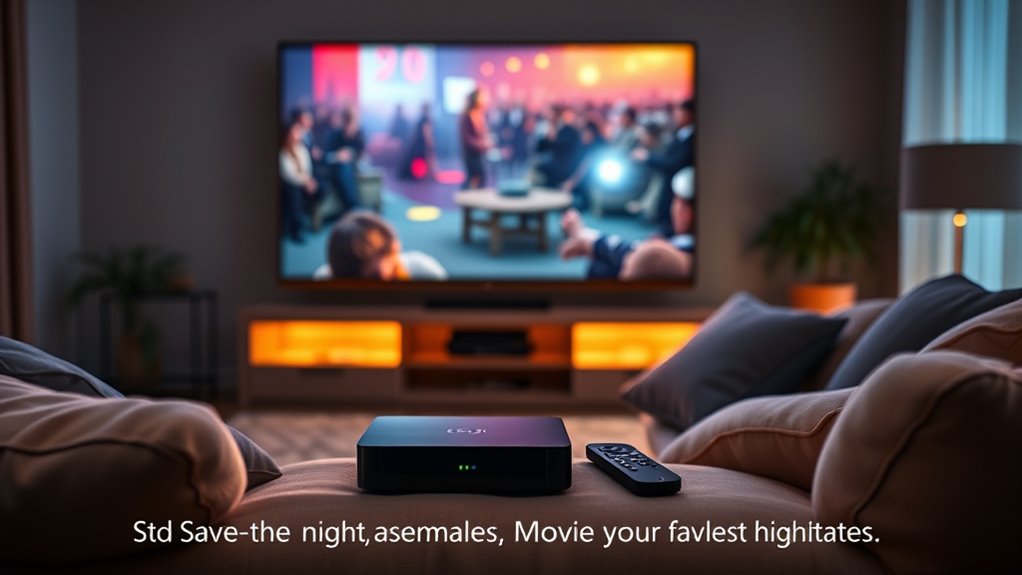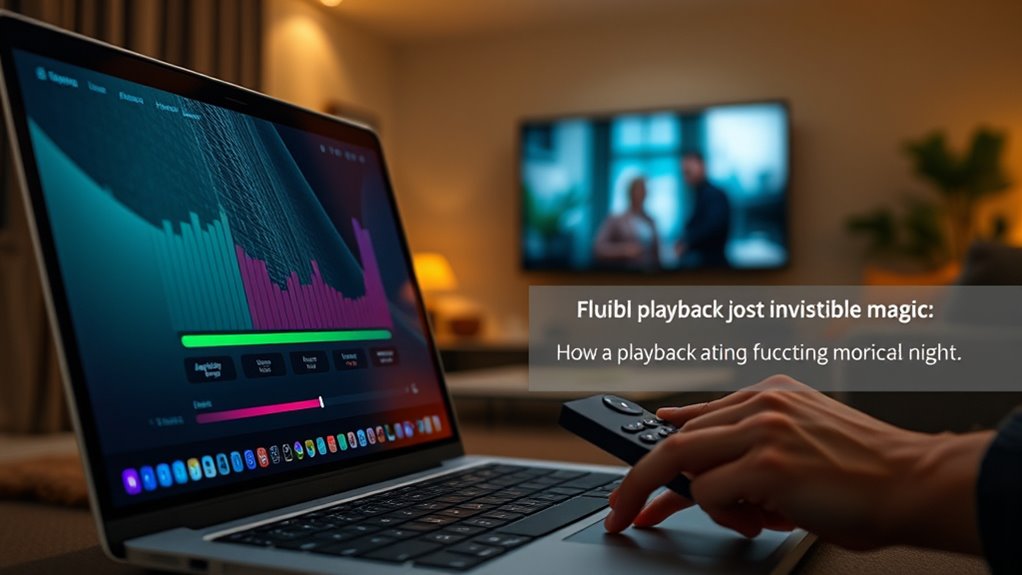Adaptive bitrate streaming keeps your movie night smooth by adjusting video quality based on your internet connection in real-time. It detects your bandwidth fluctuations quickly and lowers or raises the video resolution as needed, preventing bothersome buffering or drops in quality. This seamless adjustment makes sure your show plays without interruptions, even if your connection weakens. If you’d like to understand how this technology works behind the scenes, there’s more to discover.
Key Takeaways
- It adjusts video quality in real-time based on your internet speed to prevent buffering pauses.
- Continuously monitors network conditions to optimize playback and maintain smooth viewing.
- Uses advanced codecs to deliver high-quality video at lower bandwidths, reducing interruptions.
- Seamlessly lowers video quality during slow connections, avoiding sudden pauses or rebuffering.
- Enhances overall viewing experience by adapting to network fluctuations, ensuring uninterrupted movie nights.
Understanding Adaptive Bitrate Streaming

Adaptive bitrate streaming is a technology that adjusts the quality of a video in real-time based on your internet connection. It improves buffering management by monitoring your bandwidth and device performance, ensuring smooth playback without interruptions. When your connection slows down, the system automatically lowers the video quality, reducing the chances of annoying pauses. Conversely, when your internet speeds up, it increases the quality for a better viewing experience. This dynamic process optimizes content delivery, so you get the best possible video quality without waiting for buffering. Additionally, understanding industry trends can help providers stay ahead in delivering high-quality streaming experiences. By continuously adapting to your network conditions, adaptive bitrate streaming maintains consistent performance and prevents frustrating disruptions during your movie night. It is also beneficial to keep an eye on video compression techniques, which play a key role in enabling efficient adaptive streaming. Staying informed about network optimization strategies can further enhance your streaming quality and reliability. It’s also crucial to stay aware of AI innovations that are shaping future streaming technologies to enhance user experience even further.
How It Detects Your Internet Speed

To determine your internet speed, the streaming system continuously measures your network’s performance by sending small data packets to your device and analyzing how quickly they return. This process helps with buffering reduction and enables viewer customization. Here’s how it works:
Streaming systems regularly test your connection by sending small data packets and measuring their return speed to improve viewing quality.
- Sends brief data bursts to your device to gauge connection responsiveness.
- Monitors how fast packets are received back, evaluating bandwidth.
- Detects fluctuations in internet speed during playback.
- Adjusts streaming quality in real-time based on these measurements.
- The system actively detects passive voice in its own instructions to improve clarity and readability.
- It also adapts to network variability, ensuring a smoother viewing experience despite changing internet conditions.
- By continuously monitoring connection stability, it can better anticipate and respond to potential disruptions.
- This dynamic adjustment relies on understanding adaptive bitrate streaming principles to optimize performance.
- Additionally, it may incorporate client-side measurements to refine its detection of network issues for even more seamless streaming.
The Process of Adjusting Video Quality in Real-Time

As your device continuously monitors your internet speed, the streaming platform instantly adjusts the video quality to match the current network conditions. This dynamic process guarantees smooth content delivery and helps reduce buffering interruptions. When your connection slows, the system lowers the video resolution; when it improves, it boosts quality again. Here’s how it works:
| Network Condition | Video Quality | Buffering Impact |
|---|---|---|
| Slow/Unstable | Low (480p) | Buffering likely |
| Moderate | Standard (720p) | Less buffering |
| Fast/Stable | High (1080p) | Minimal buffering |
| Very Fast | Ultra HD (4K) | No buffering |
| Fluctuating | Adaptive changes | Reduced buffering |
This process optimizes content delivery, making your movie night seamless and enjoyable. Additionally, adaptive bitrate streaming ensures that viewers experience the best possible quality based on their current network conditions.
Benefits of Adaptive Streaming for Viewers

With adaptive streaming, you enjoy smooth playback without interruptions, even on fluctuating internet connections. It also helps you save data by adjusting video quality based on your usage. As a result, you get a better viewing experience that’s both reliable and efficient. Additionally, it can optimize your bandwidth usage by adjusting video quality in real-time to match your connection speed. This technology is similar to how Hyundai Tuning enhances vehicle performance by fine-tuning various components to match conditions. By intelligently managing network resources, adaptive streaming ensures consistent video quality regardless of network variability, similar to how commercial grade heat pumps are optimized for different building demands through advanced technology.
Seamless Playback Experience
Adaptive bitrate streaming guarantees that your viewing experience remains smooth and uninterrupted, even when your internet connection fluctuates. This technology prevents buffering issues by adjusting video quality in real-time, ensuring seamless content delivery. Here’s how it benefits you:
- You avoid frustrating pauses during playback.
- You enjoy consistent video quality without sudden drops.
- You stay engaged without repeatedly reloading or buffering.
- You experience fewer interruptions, even with unstable connections.
- Data analytics help streaming platforms optimize content delivery for each viewer.
- By dynamically adjusting video quality, adaptive streaming also helps conserve bandwidth, allowing for better performance on various internet speeds.
- Modern video compression techniques further enhance streaming efficiency, ensuring high quality even on limited bandwidth.
- Additionally, adaptive streaming supports multi-device compatibility, making it easier to watch content across smartphones, tablets, and smart TVs.
- Incorporating adaptive algorithms inspired by advanced network management techniques can further refine streaming stability and quality.
Data Usage Optimization
By adjusting video quality in real-time, adaptive bitrate streaming helps you use data more efficiently. It manages your bandwidth by dynamically switching to the appropriate quality level based on your internet connection. This prevents unnecessary data consumption when your connection is slow or unstable. Data compression plays a key role, reducing the size of video files without sacrificing too much quality, which further conserves your data. Support hours for streaming services can influence when you experience optimal quality, especially during peak viewing times. With smarter bandwidth management, you avoid buffering and excessive data use, saving both your data plan and ensuring smoother streaming. Implementing video quality optimization techniques can further enhance your viewing experience by balancing quality and data use. This means you can enjoy longer viewing sessions without worrying about overage charges or interrupted playback. Additionally, understanding network conditions can help you select the best streaming settings for your situation, making your movie night even more seamless. Overall, adaptive streaming optimizes data usage, giving you a better, more cost-effective streaming experience.
Common Technologies Behind Adaptive Bitrate Streaming

You rely on video codec efficiency to guarantee smooth streaming without using too much bandwidth. Dynamic quality adjustment then helps your device switch seamlessly between different video qualities based on your connection. Together, these technologies make adaptive bitrate streaming effective and reliable.
Video Codec Efficiency
Video codec efficiency plays a crucial role in adaptive bitrate streaming by determining how well video data is compressed without sacrificing quality. Over time, video codec evolution has led to more efficient technologies, enabling smoother streaming experiences. Better codecs mean smaller file sizes, which improve bandwidth management, especially in limited network conditions. Here’s what you should know:
- Advanced codecs like H.265/HEVC and AV1 deliver higher compression rates than older formats.
- They maintain crisp quality even at lower bitrates, reducing buffering.
- Efficient codecs optimize bandwidth, ensuring seamless streaming on various devices.
- Continuous codec improvements enable better adaptive streaming, saving your movie night from interruptions.
Dynamic Quality Adjustment
Dynamic quality adjustment is the core technology that allows streaming platforms to automatically modify video resolution and bitrate in real-time, based on your network conditions. It guarantees smooth content delivery by continuously monitoring your connection and adjusting streams to prevent buffering. This process relies on efficient buffer management, which helps maintain a steady data flow even during fluctuating bandwidth. By selecting the most suitable stream quality, it minimizes interruptions and maximizes viewer satisfaction. The table below illustrates key components involved:
| Component | Function | Benefit |
|---|---|---|
| Buffer Management | Stores video segments to match network speed | Prevents buffering and stalling |
| Content Delivery | Transmits appropriate quality streams | Ensures seamless viewing |
| Adaptive Algorithms | Analyze network conditions in real-time | Dynamically adjusts quality |
This seamless adjustment keeps your movie night smooth, regardless of network hiccups.
Troubleshooting Streaming Interruptions

When streaming interruptions occur, identifying the root cause quickly can save you time and frustration. Common issues include buffering delays and device compatibility problems. To troubleshoot effectively:
- Check your internet connection speed to reduce buffering delays.
- Restart your device or app to resolve temporary glitches.
- Ensure your device’s software and streaming app are up to date for better compatibility.
- Try switching to a different device or browser if problems persist, as some devices handle streaming better than others.
If buffering delays are frequent, lowering the stream quality can help. Confirm that your device supports the streaming platform’s requirements. Addressing these issues promptly keeps your movie night smooth and enjoyable.
Future Trends in Streaming Technology

Advancements in streaming technology are set to revolutionize how you experience digital content, building on the improvements in troubleshooting and device compatibility. Future trends like cloud gaming will let you play high-quality games directly through streaming, eliminating the need for powerful hardware. Virtual reality will become more immersive and accessible, offering lifelike experiences from your living room. These innovations rely on faster, more efficient data transfer and adaptive bitrate streaming to reduce lag and buffering. As networks evolve, expect seamless progression between devices and higher resolutions in real-time. AI-driven algorithms will personalize content delivery, making your viewing and gaming experiences more tailored and responsive. Overall, these advancements will make digital entertainment more immersive, flexible, and hassle-free than ever before.
Frequently Asked Questions
Can Adaptive Streaming Work on All Devices and Platforms?
Adaptive streaming works on most devices and platforms, thanks to its flexible design. You benefit from broad device compatibility and cross-platform support, ensuring smooth playback whether you’re on a smartphone, tablet, or smart TV. Developers optimize adaptive streaming for various operating systems and browsers, making it accessible and reliable for everyone. So, no matter what device you use, adaptive bitrate streaming is likely to work seamlessly, enhancing your viewing experience.
How Does Adaptive Streaming Impact Data Usage and Bandwidth?
Adaptive streaming impacts your data usage and bandwidth by optimizing how video quality adjusts to your internet speed. When your connection is fast, it delivers higher quality, increasing data consumption. Conversely, it lowers quality on slower connections, saving bandwidth. This process guarantees efficient bandwidth optimization, reducing unnecessary data use while maintaining smooth playback. So, you get a better viewing experience without overloading your data plan or bandwidth, making streaming more efficient and enjoyable.
Is Adaptive Bitrate Streaming Suitable for Live Sports Events?
Did you know that 70% of viewers abandon streams due to buffering delays? Adaptive bitrate streaming is perfect for live sports because it adjusts quality in real-time, reducing buffering and ensuring smooth viewing. It handles content licensing restrictions efficiently while maintaining high-quality streams. So, yes, adaptive streaming is highly suitable for live sports events, keeping you engaged without interruptions, no matter your internet speed.
What Are the Privacy Considerations With Adaptive Streaming Technologies?
You should be aware of privacy concerns with adaptive streaming, as it involves data collection to optimize your viewing experience. Streaming services gather information like your device type, location, and viewing habits, which can raise privacy issues if misused. To protect yourself, review privacy policies, use secure networks, and consider disabling personalized ads. Staying informed helps guarantee your data remains private while enjoying seamless streaming.
How Does Adaptive Streaming Handle Sudden Internet Speed Drops?
Imagine your internet speed drops so suddenly, it’s like hitting a brick wall! Adaptive streaming handles this chaos with lightning-fast buffer management and error correction. It instantly detects the slowdown, switches to a lower quality stream, and keeps your movie playing smoothly—no freezing or crashing. This smart tech guarantees your binge-watching marathon stays uninterrupted, even when your connection takes a nosedive, saving your movie night from disaster.
Conclusion
With adaptive bitrate streaming, your movie night stays smooth like a calm lake, regardless of internet hiccups. It’s your digital guardian, adjusting video quality on the fly so you never miss a moment. As streaming technology evolves, expect even smarter, more seamless experiences that keep your entertainment flowing effortlessly. Embrace these innovations, and let your viewing adventures be as steady as a lighthouse guiding ships home—bright, reliable, and always there when you need it.















